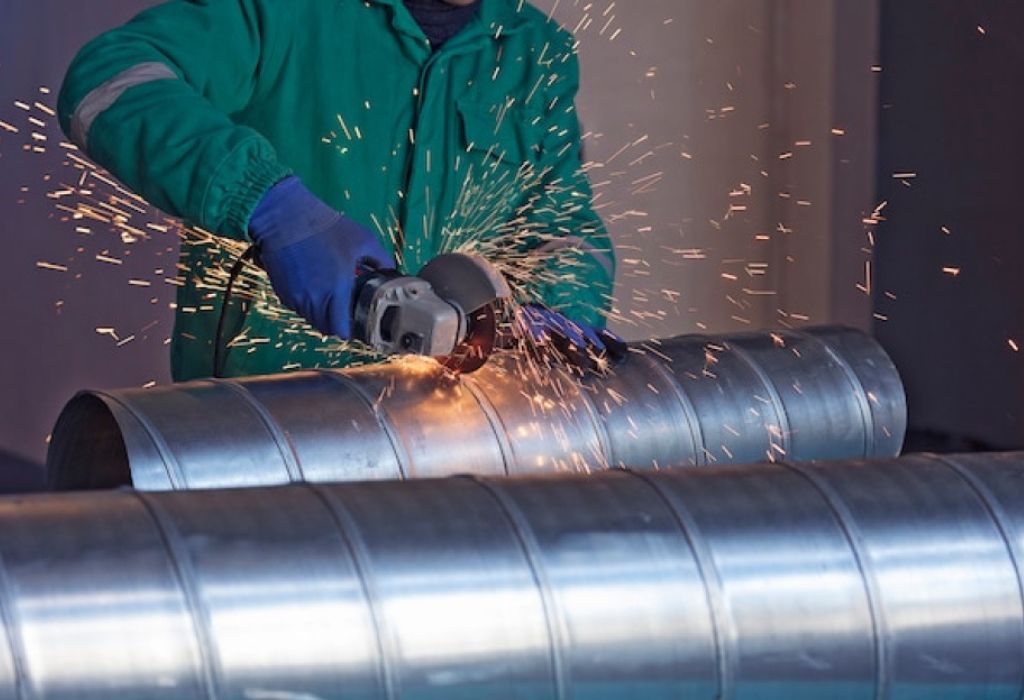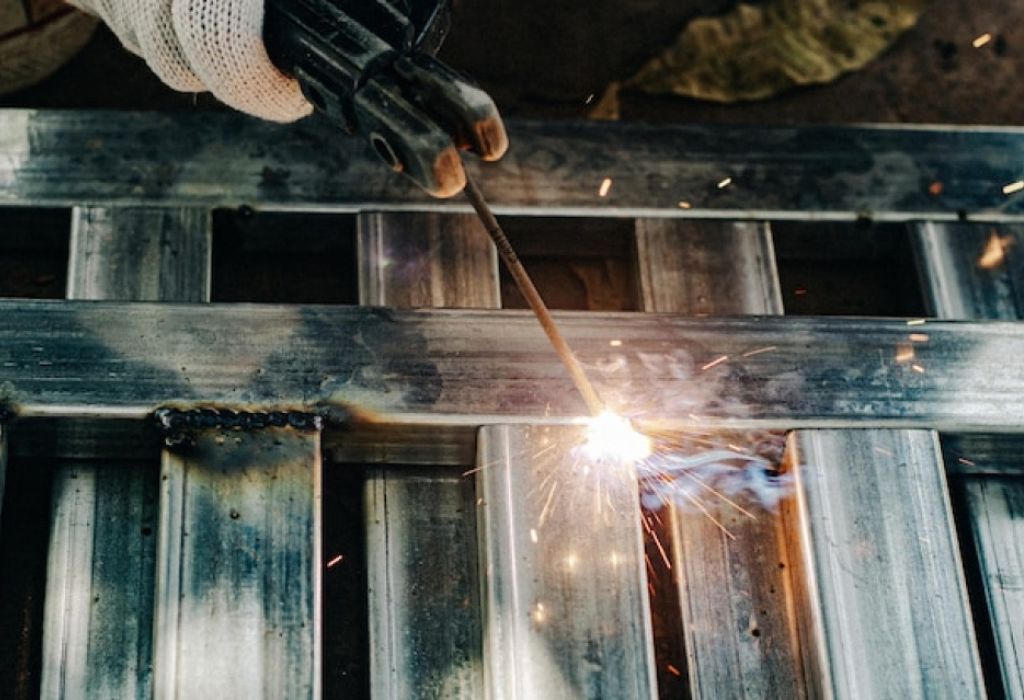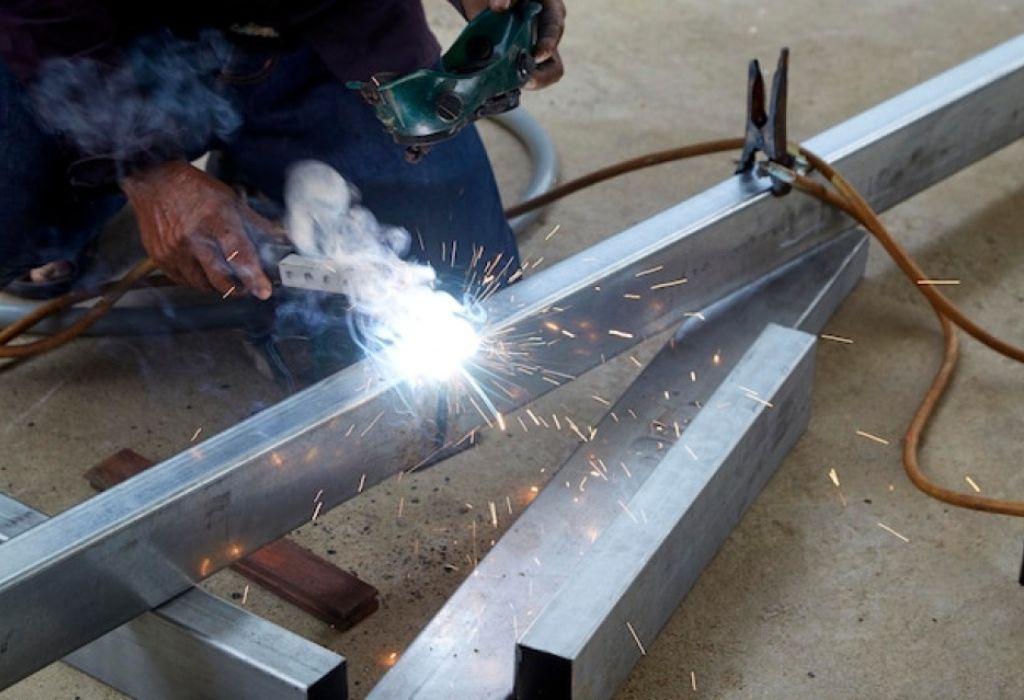Welding a piece of galvanized steel may seem harmless — until you notice thick white smoke filling the air.
That smoke carries zinc oxide fumes, invisible particles that can make you sick within hours.
Every year, welders report thousands of cases of metal fume fever, a short-term flu-like illness caused by inhaling zinc fumes (OSHA — Permissible Exposure Limit: 5 mg/m³ TWA).
This is why knowing how to handle galvanized steel safely is not optional — it’s critical.
So, can you weld galvanized steel at all?
Yes, you can — but you need to understand the risks, remove coatings properly, use the right processes, and protect yourself from dangerous fumes. This guide walks through everything step-by-step to keep your welds clean and your lungs clear.
What Galvanized Steel Is — and Why It’s Risky to Weld

Galvanized steel is regular carbon steel coated with zinc to prevent corrosion.
The zinc layer acts as a protective barrier and provides cathodic protection against rust.
When exposed to welding heat, that zinc coating vaporizes at around 900 °C (1650 °F), forming zinc oxide fumes.
Those fumes can irritate lungs and trigger metal fume fever, especially in enclosed spaces.
What is galvanized steel used for?
It’s found in pipes, fences, HVAC ducts, auto frames, and building structures due to its rust resistance.
Why does welding produce white smoke?
The white smoke is zinc oxide — produced when zinc vaporizes and reacts with oxygen around the arc (American Galvanizers Association).
What is metal fume fever?
It’s an acute reaction to metal fumes that causes chills, nausea, and fatigue, usually within 4–8 hours of exposure.
Is welding galvanized steel always dangerous?
It’s risky only when you don’t remove coatings or use proper ventilation.
Do coatings other than zinc cause problems?
Yes — paints, primers, or chromates can release toxic compounds like lead or cadmium, which are even more hazardous.
Can You Weld Galvanized Steel Without Removing the Coating?
Technically yes, but it’s not recommended.
When zinc burns off under the arc, it contaminates the weld, increases spatter, and fills the workspace with fumes.
Welding galvanized metal “as is” should only be attempted with strong local exhaust ventilation (LEV), appropriate PPE, and acceptance by your welding engineer.
Most codes, including AWS D19.0, advise grinding off the coating at least 1–4 inches (25–100 mm) from each side of the weld.
Is removing the zinc always required?
Yes, whenever possible — grinding to bare steel ensures cleaner welds and reduces fume emissions.
What if I can’t remove the coating?
Use powerful extraction, smaller beads, and frequent pauses to let fumes clear.
Will welding outdoors help?
It reduces accumulation but doesn’t eliminate zinc oxide risk — you still need LEV or fume extraction.
Does short tack welding release fewer fumes?
No — most zinc fumes are produced at the start of each arc.
Can you “burn off” zinc first?
Never — intentionally heating zinc coating releases concentrated fumes and can violate OSHA exposure limits.
Safe Welding Controls — PPE and Ventilation
Before striking an arc, protect yourself and the area.
Fume control and personal protective equipment form your first line of defense.
Ventilation: Use local exhaust or on-torch extraction to capture fumes at the source.
General shop ventilation isn’t enough; zinc fumes disperse quickly but linger in breathing zones.
Respiratory Protection: A PAPR (Powered Air-Purifying Respirator) or a respirator with filters rated for metal fumes (per OSHA 29 CFR 1910.134) is recommended.
Ensure proper fit and maintenance according to your facility’s safety plan.
Monitoring: OSHA’s Permissible Exposure Limit (PEL) for zinc oxide fume is 5 mg/m³ (8-hour TWA), while NIOSH recommends a 10 mg/m³ STEL (NIOSH Pocket Guide).
Regular air monitoring ensures compliance and early detection of high exposure.
What’s the minimum safety setup?
At least use LEV positioned near the weld pool to pull fumes away.
What respirator works best?
Use a PAPR or half-mask respirator with P100 filters for metal fumes.
What symptoms signal overexposure?
Headache, metallic taste, fever, or nausea within hours — classic metal fume fever signs.
Can zinc fumes cause permanent damage?
Prolonged or repeated exposure can affect lung function and immune response over time.
Is “holding your breath” a substitute for PPE?
Never — zinc fumes spread instantly once the arc strikes.
Surface Preparation — The Key to Safe and Clean Welds
The most effective way to control zinc fumes is removing the coating where you’ll weld.
Mechanical grinding is the safest and most common method.
Use an abrasive wheel or flap disc to strip 1–4 inches (25–100 mm) of coating from each side of the joint.
Chemical stripping is also possible in industrial environments, but it requires neutralization and environmental controls.
How much coating should I remove?
At least one inch around the weld; four inches for thicker coatings or multi-pass welds.
Is grinding enough?
Yes — for most jobs, mechanical removal exposes clean steel without extra chemicals.
Can I weld directly over thin coatings?
You can, but expect porosity, spatter, and weaker fusion zones.
Do I need to clean after grinding?
Yes — remove dust, oil, or moisture before welding.
Why is edge prep important?
Clean bevels reduce zinc entrapment and improve gas flow, reducing porosity risk.
Welding Processes That Work Best

You can weld galvanized steel using SMAW (Stick), GMAW (MIG), FCAW (Flux-Cored), or GTAW (TIG) — provided you control fumes and prep surfaces properly.
SMAW (Stick): Good for outdoor or structural work where fume extraction is easier. The flux helps counteract minor zinc contamination.
GMAW (MIG): Produces clean, fast welds but requires clean bare metal for consistent arcs.
FCAW: Excellent for thicker sections and better tolerance for coating remnants.
GTAW (TIG): Best for thin material and precise control, but demands complete coating removal.
Resistance Spot Welding: Common in sheet-metal fabrication, especially automotive, where zinc coatings are thin.
Which process is most forgiving?
Flux-cored and stick welding can handle small traces of zinc better than MIG or TIG.
What shielding gas should I use for MIG?
Use a CO₂/argon mix (C25) with pre-cleaned steel for smooth arc stability.
Can I spot-weld galvanized sheet?
Yes — resistance spot welding is widely used on coated steel sheets.
Does higher voltage help?
No — too much heat burns more zinc and increases fume output.
Can TIG welding handle galvanized metal?
Yes, but only after full coating removal; zinc severely affects puddle control.
Preventing Porosity, Spatter, and Cracking
Zinc contamination in the weld pool causes porosity and poor fusion.
Using proper prep and parameter control helps avoid these common flaws.
A slightly higher travel speed and correct electrode angle help direct fumes away from the arc.
Small weave patterns and intermittent beads also reduce heat buildup and fume release.
Why do weld beads bubble on galvanized steel?
Zinc vapor expands in the molten pool, creating trapped gas pockets.
Does preheating help?
Mild preheat (150–250 °F) may help with thicker parts but isn’t required for thin sheet.
Should I push or pull when MIG welding?
Use a push technique to direct fumes forward and improve visibility.
Which filler rods work best?
Standard carbon-steel fillers (E7018, ER70S-6) work fine once zinc is removed.
Can short welds reduce fumes?
Yes — stitching or back-stepping limits heat and fume concentration.
After Welding — Restoring Corrosion Protection
Once welded, the surrounding zinc coating is burned off, leaving bare steel that will rust quickly.
Always recoat the weld area using zinc-rich repair products.
ASTM A780 provides three approved methods for coating repair:
- Zinc-rich paint or spray.
- Zinc soldering or metallizing.
- Zinc thermal spraying (hot metalizing).
Why must you repair the coating?
Because the exposed steel near the weld will corrode faster without zinc protection.
What product should I use?
Use a cold galvanizing compound with at least 90% zinc content in dry film.
When should repair be done?
After cooling and cleaning the weld, before exposure to moisture or outdoor air.
Can you re-galvanize the entire piece?
Yes, if the part can be dipped again — this ensures full coating restoration.
How to confirm the repair works?
Measure coating thickness and ensure uniform coverage per manufacturer’s specification.
Field vs. Shop Welding — Key Differences
Welding galvanized steel in the shop is easier because you can engineer better ventilation.
In the field, mobile fume extraction units and PPE become non-negotiable.
Field welding: Use portable LEV arms, respirators, and minimal wind interference.
Shop welding: Fixed hoods and extraction ducts keep fume concentration low.
Can I weld galvanized fence posts outdoors?
Yes, but grind off zinc around the weld and use cold galvanizing spray afterward.
Is muriatic acid stripping safe onsite?
No — it produces hazardous gases. Mechanical grinding is the safer method.
How do HVAC installers weld galvanized ducts?
They use short beads, low amperage, and good ventilation, often switching to spot or resistance welds.
Does field work need more PPE?
Always — open areas can’t replace LEV near the arc.
Who authorizes welding on galvanized structures?
Follow approved procedures signed off by your welding engineer or safety officer.
Quick Checklist — “Can You Weld It Safely?”

Before starting, go through this four-step checklist: Prep → Ventilate → Weld → Repair.
If any step is skipped, the job is unsafe.
If you can’t remove zinc, can you still weld?
Only with documented approval, heavy extraction, and respiratory protection.
What’s the most important safety control?
Local exhaust ventilation placed right at the arc.
Which standards apply?
Follow AWS D19.0 for welding zinc-coated steel and ASTM A780 for coating repair.
How do you monitor health risks?
Use air sampling and keep zinc oxide below OSHA and NIOSH limits.
What’s the golden rule?
If you see white fumes, stop — improve ventilation before continuing.
Common Mistakes to Avoid
- Welding without grinding off zinc coating.
- Assuming outdoor work is safe without fume extraction.
- Ignoring post-weld coating repair.
- Using the same voltage and amperage as uncoated steel.
- Forgetting to monitor air quality in confined spaces.
Conclusion
So, can you weld galvanized steel? Absolutely — but only if you do it safely.
The zinc coating that protects the steel becomes hazardous when vaporized by heat.
Always remove the coating near the weld, use proper extraction, and wear PPE rated for metal fumes.
Then, restore the zinc protection after welding using approved zinc-rich coatings per ASTM A780.
Welding galvanized steel is common in structural, HVAC, and farm equipment work — and with correct preparation, it’s completely safe.
Remember: Prep, Extract, Weld, Repair. Follow these four words every time you strike an arc.

I’m Darrell Julian, the founder, lead writer, and hands-on welding enthusiast behind ArcWeldingPro.com. With more than 15 years of real-world welding experience, I created this platform to share what I’ve learned in the field, in the shop, and in the heat of the arc.


